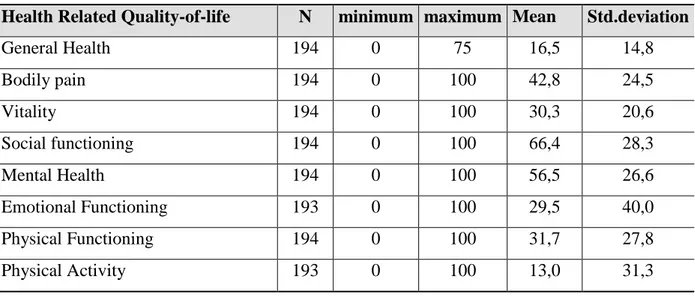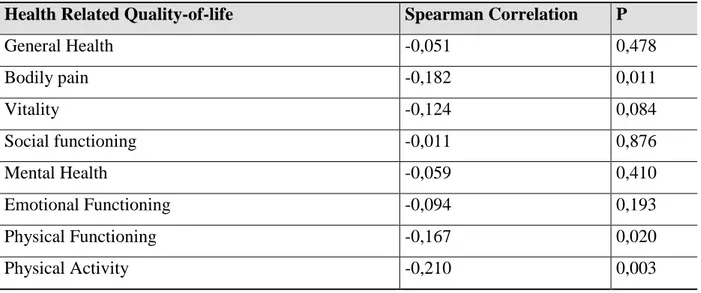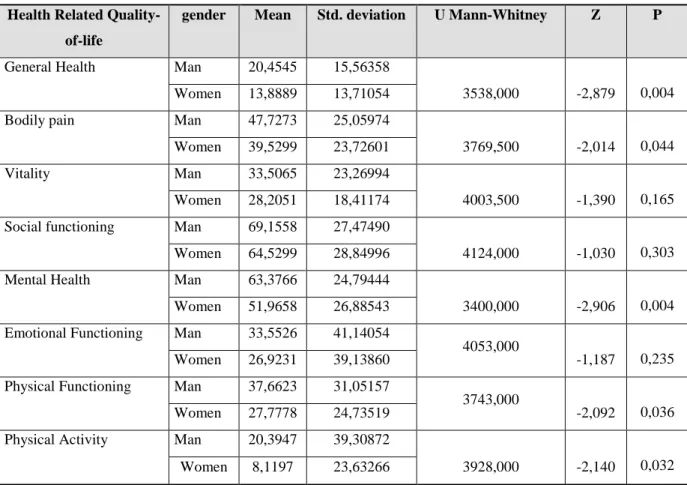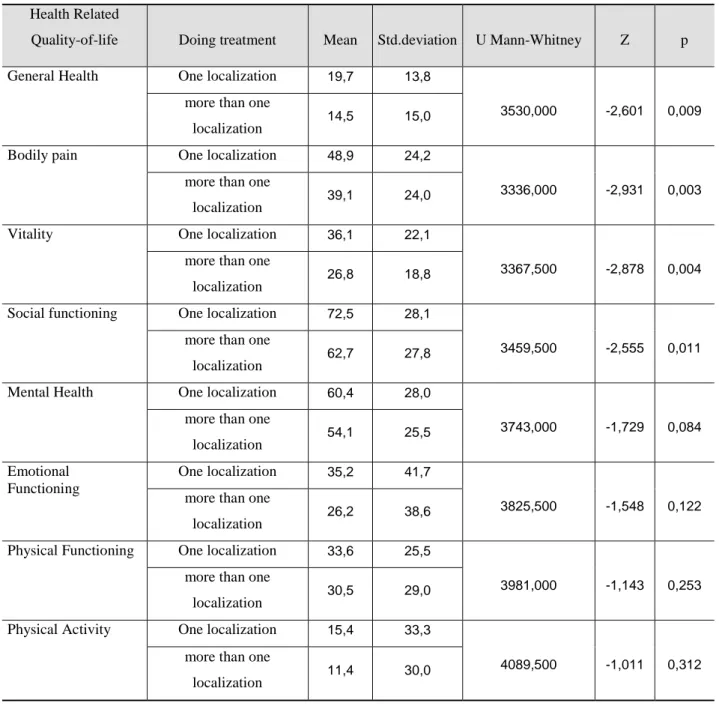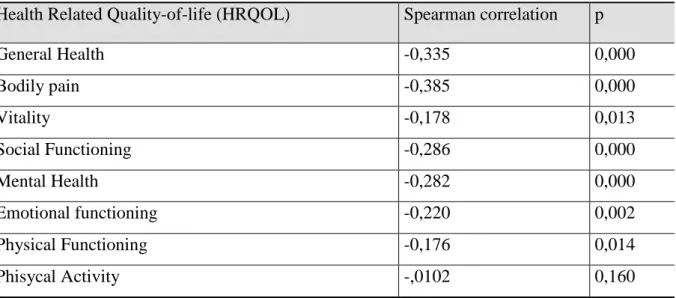Quality of Life of the Elderly People with Chronic Pain. Authors:
Maria dos Anjos Coelho Rodrigues Dixe** Ana Isabel Querido* **
WORK PLACE: Escola Superior de Saúde de Leiria do Instituto Politécnico de Leiria
ADDRESS: Escola Superior de Saúde – IPL~
Campus 2 - Morro do Lena 2411-901 Leiria – Portugal
TELEPHONE: 964881092
E-MAIL: querido.ana@gmail.com
* Tema a apresentar em congresso por Ana Isabel Querido ** Professora coordenadora
** *Professora adjunta e aluna de Doutoramento.
Quality of Life of the Elderly People with Chronic Pain
Aims: To determine the prevalence of Chronic Pain in Elderly People, to evaluate
health-related quality-of-life of the elderly experiencing pain; and determine predictive factors of their quality-of-life.
Methodology: A Cross sectional co-relational study was conducted. The sample for this study
was composed of 296 elderly people, to determine the pain prevalence and subsequently just 194 seniors remained part of the sample, because they were those who had chronic pain. The instrument of data collection was a structured interview composed of: socio-demographic, family, professional and clinical data and Short-Form Health Survey – SF-12
Main results: The prevalence of the chronic pain in the elderly people is 65,5% (164).
Most reported having pain for ten years or more, it is a continuing pain, and it is felt in various places with moderate intensity; the quality of life of elderly people is bad in all dimensions. Have an occupation, age, gender; pain intensity and location of pain are predictors of quality of life
INTRODUCTION
In the 21st century we are assisting an increasing life expectancy, where older people prevail in face of illness. The recent WHO report showed that, on the whole, people live longer today than 30 years ago. By the year of 2050, the word will count 2 billion people over the age of 60, most of them living in urban areas (WHO, 2008).
Ageing has increased the burden of chronic disorders and the frequency of multimorbility. In the industrialized world, 25% of people of 65-69 years old and 50% of 80-84 years olds are affected by two or more chronic health conditions simultaneously, and present complex symptoms (WHO, 2008). Most of age-related diseases are associated with chronic pain and disability which makes it, a major public health issue throughout the world (Brennan & Cousins, 2004).
Pain is a multidimensional phenomenon with physical, psychological, social and spiritual components. The International Association for the Study of Pain (IASP) defines pain as an unpleasant sensory and emotional experience associated with actual or potential tissue damage or described in terms of such damage by people that experiences pain, and considered chronic if persists the normal time of healing usually for more than 3 months (IASP, 1994). It is widely recognized that chronic pain is associated with depressive disorders, psychological distress, and impairment of interpersonal relationships. Pain is one of the most important problems that considerably impair autonomy and independence in daily living activities of elderly people (Jakobsson, Hallberg & Westergreen, 2004).
Caraceni et al (2002) stated that descriptive studies of pain are needed to define the prevalence, severity and scope of pain in various patient populations. These include prevalence and severity studies to evaluate pain, clarify clinical variability, pain course and quality of care in specific populations as the elderly.
A recent study conducted by Zannocchi et al (2008) showed that chronic pain in the elderly has a strong affective component and its intensity influences older patients' mood, nutrition, sleep and Quality of life (QOL). These authors stated the importance of pain assessment in the elderly, as a population at increased risk for under-recognition and under-treatment. Dewar (2006) also point out lack of research on assessing the impact of chronic pain on the psychosocial well-being of the older person living in the community.
There are several definitions of QOL in the literature, as a multidimensional concept, but in research among patients there is a lack of consensus about theoretical approaches (Chandra e
Orztuk, 2005). Regarding elderly community populations there is no evidence of a universally validated outcome test to measure it. Because we were interested in comparing chronic pain and QOL in Portuguese older people we choose to use an assessment of the Short Form Health Survey, validated and cultural adapted to this specific population.
The aims of this study were to examine the prevalence of chronic pain in the elderly and correlate chronic pain and quality-of-life in a sample of community living older people (aged 65 and more). We purposed to describe chronic pain in community living elderly people; to evaluate health-related quality-of-life of the elderly experiencing pain; and determine predictive factors of their quality-of-life.
METHOD Design
Cross sectional and co-relational study.
Participants
The study Population consisted of males and females aged 65 and more years (considered older people by Portuguese Constitutional Law).
Sample was selected using non probabilistic and accidental method and consisted of 296 older people which attended to the community health centers in Leiria’ district (centre of Portugal) during 2008.
Inclusion criteria were: aged 65 or more, living in the community setting, ability and capacity to verbally responds to interview, space and time oriented, absence of psychiatric disorders documented, to accept to participate in the study.
All participants were first asked about the presence of chronic pain. 194 confirm chronic pain which became the final sample.
Instruments
We developed and organized a structured interview divided in two parts: I. socio-demographic variables and clinical variables; II. Quality of life (SF-12)
As Socio-demographical variables we assessed age, gender, current civil status, current social status, and current work.
Clinical variables consisted of pain history: intensity using simple verbal scale graded in 5 intensity levels (0= no pain till 4=maximum pain). This scale was chosen based on clinical guidelines for pain assessment in Portuguese speaking elderly, which states that a simple verbal scale using words familiar to both patients and health professionals minimize the bias on pain assessment (Direcção-Geral da Saúde, 2003; Andrade, Pereira, Sousa e Aparecida, 2006). Pain duration / length of pain and temporal pattern (continuous, intermittent), causes, location, type of pain / quality, type of treatment for pain control.
The second part of the instrument consists in assessment of health related quality-of-life (HRQOL) using the Medical Outcomes Study: Short Form (MOS SF-12) first developed by Sherbourne in 1992, translated and validated into Portuguese by Ribeiro (2007).
The SF-12 consists on 12 items dived into scales to measure eight domains of HRQOL: physical functioning (2 items); role impairment due to physical problems (2 items); bodily pain (1 item); general health perception (1 item); vitality (1 item); social functioning (1 item); role impairment due to emotional problems (2 items); mental health (2 items). There is one more item assessing health transitions, perceived by the individual.
Procedures
Ethics
We asked authorization for the present study to the president of Administração Regional de Saúde (Regional Health Administration).
Before data collection we also asked the participants for consent to participate in the study. We provide written and oral information, explaining the aims of the study. We clearly stated that participation was voluntary and that confidentiality was assured. Thereafter participants gave their informed consent.
Data collection and statistical procedures
The instruments were applied during the year of 2008, at Health Care Centers. In order to guarantee privacy, face-to-face interviews were conducted in a division especially designate for the procedure.
Data were submitted to quantitative analysis using Statistical Package for the Social Sciences (SPSS) version 16.0 for Windows. In addition of descriptive statistics, we used Kolmogorov-Smirnof’ to test data normality distribution. Inferential statistics was used to correlate
variables. Non-parametric statistics were used as the data were not normally distributed for all the variables in study.
RESULTS
Prevalence of chronic pain in the elderly
From 296 older people interviewed, 194 had chronic pain. Therefore, the prevalence of chronic pain is 65,5%. Comparing with our findings lower scores were reported in other studies (Helme & Gibson, 2001) and Dellaroza, Matuso, Pimenta & Anducioli de Mattos, 2007).
Socio-demographical characterization
From the 194 elderly experiencing chronic pain, 117 (60,3%) are females and 77 (39,7%) are males. These results are similar to those presented by Portuguese Association for the study of pain (APED; 2007) and Rippentrop (2005), in which chronic pain has higher incidence in women.
The participants of the study were elderly between 65 and 98 years old. The mean age is 74,9 SD=6,7), which confirm that prevalence of pain increases with age, as previously stated by Helme e Gibson (2001).
The majority of the sample 122 (62,9%) were married, 62 (32%) widowed, 6 (3,1%) were single and 4 (2,1%) divorced. 112 (57,7%) of elderly lived with husband or spouse, 52 (26,8%) lived alone, 30 (15,5%) lived with family (including relatives, sons, daughters, husband or spouse)
Only 47 (24,2%) of the elderly had an occupation. Most of elderly 147 (75,8%) did not refer any work occupation.
Description of chronic pain in community living elderly people
During data collection elderly people report intensity pain levels between 0 – 4, with mean of 2,3 (SD=1,1): 21,1% (41) report maximum pain; 17,0% (33) intensive pain; 44,8% (87) mild pain; 10,8% (21) light pain. Only 6,2% (12) report no pain at all. These results are not similar to the findings of Jakobsson, Hallberg e Westergreen (2004) in which 29% of elderly people reporting very much pain, 34% reporting rather much pain and 38% reporting little pain.
When questioned about temporal pattern of pain, most of the elderly 60,3% (117) identify continuous pain, and 39,7% (77) referred intermittent pain. Regardless of pain patterns, in mean, elderly people identify chronic pain for over 12 years (SD=10).
These data are similar to the findings of Mason, Skevington e Osborn (2008), in which 66,2% (143) of patients experienced continuous chronic pain. These authors report presence of pain for over 9 years in the 216 participants
Osteoarticular disease was the principal cause for chronic pain for 123 (63,4%) elderly, followed by cardiovascular disease (24; 12,4%), accidents (15; 7,7%), neurological diseases (5; 2,6%) and other not specified (13,9%).
These findings are consonant with other previous studies, for example Jakobsson, Hallberg e Westergreen (2004). In Portugal, osteoarticular disturbances are indicated as the major cause for non malignant localized chronic pain (Direcção Geral da Saúde, 2001). Osteoarthritis (34%) and rheumatic diseases (14%) are the major causes of chronic pain (Viveiros, 2008). Most participants of our study had pain in more than one localization (122; 62,9%). One single pain was indicated by 37,1% (72) elderly people. Although 194 elderly persons experienced chronic pain, only 145 (74,7%) did some kind of treatment to pain control. 49 (25,3%) didn’t any kind of pain treatment. Considered the main concern of health care providers regarding patients pain control and quality of life, these numbers expressed poor pain control if compared with others studies Jakobsson, Hallberg e Westergreen (2004) in which only 3,8% of the inquiries wasn’t doing pain control treatment.
Pharmacological treatment were the most used (113; 79,6%) followed by an integrated approach using pharmacological and non pharmacological interventions (18,3%). Only 3 participants (2,1%) choose non pharmacological approaches to control chronic pain. In the study of Sanocchi et al (2008) only 37,9% of the elderly persons controlled the chronic pain with pharmacological analgesic therapy.
Analyzing these data, we may infer that the majority of elderly people only use one kind of treatment to pain control.
Quality-of-life of elderly people experiencing chronic pain
Analyzing table 1, the participants of the present study seem to evidence low quality-of-life in several dimensions assessed by SF-12, scoring in mean values lower than 50: general health perception (mean of 16,5; SD=14,8); bodily pain (mean 42,2; SD=24,5); vitality (mean of
30,3, SD=20,6); emotional functioning (mean of 29,5 ; SD=40); physical functioning (mean of 31,7; SD= 27,8); physical activity (mean of 13; SD=31,3).
Reyes-Gibby (2002) and Dias (2007) also stated that in community living elderly people, experiencing pain on a daily-basis, is related to poor and fragile health status. Hopman-Rock, Kraaimaat e Bijlsma (1997) also reported a relatively low QOL in elderly people with more non malignant chronic pain symptoms.
Social dimension is referred by the elderly as the one with better quality of life, with mean values on social functioning of 66,4 (SD=28,3). These results are contrasting with findings of Sofaer-Bennett, Couns, Walker, Lamberty e O’Dwyer (2007), in which the participants appeared to regret the demise of their social life. They faced pain-related limitations and uncertainties that led to social withdrawal for themselves and social isolation for them and their spouse or partner.
Vasconcelos (2006) stated that elderly people with chronic pain had changes in daily living activities: 30% in walking, 20% in standing, and 20% present difficulties in social relations. Mental health and social health dimensions do not confirm literature review. Findings of Berkow, Beers, Bogin e Fletcher (2002) evidence psychological disturbances associated with chronic pain: enhancing of irritability, mood disorders, worries about self –image, distancing from others and depression.
Table 1: Sample characterization of Quality-of-life Dimensions
Health Related Quality-of-life N minimum maximum Mean Std.deviation
General Health 194 0 75 16,5 14,8 Bodily pain 194 0 100 42,8 24,5 Vitality 194 0 100 30,3 20,6 Social functioning 194 0 100 66,4 28,3 Mental Health 194 0 100 56,5 26,6 Emotional Functioning 193 0 100 29,5 40,0 Physical Functioning 194 0 100 31,7 27,8 Physical Activity 193 0 100 13,0 31,3
Table crossing quality-of-life and age, evidenced statistical significance correlations on item “Bodily pain”; “Physical Activity” and “Physical Functioning” (Table 2). Correlations are statistically significance (p<0,05) and negative, evidence that less age is correlated with better quality of life regarding experiencing pain, physical functioning and physical activity. These data are similar to the findings of Jakobsson, Klevsgard, Westergren e Hallberg (2003) in which the quality of life, especially physical health, was significantly lower with increasing age.
Table 2 - Spearman correlation between quality-of-life and age
Health Related Quality-of-life Spearman Correlation P
General Health -0,051 0,478 Bodily pain -0,182 0,011 Vitality -0,124 0,084 Social functioning -0,011 0,876 Mental Health -0,059 0,410 Emotional Functioning -0,094 0,193 Physical Functioning -0,167 0,020 Physical Activity -0,210 0,003
When comparing gender of elderly with chronic pain, we verified that gender is a variable predictive of HRQOL in several dimensions, such as General Health, Bodily pain, Mental Health, Physical Functioning and Physical Activity. Although the limitation of Mann-Whitney U-test is using means to extract the differences, we verified that men had means of HRQOL better than women (Table 3). These data are similar to the findings of Zannocchi et al (2008), in which the intensity of pain influences quality of life
Also, in the study of Nejati1 et al (2008) the mean scores between the two genders showed that these scores were higher in men in aspects of physical functioning, general health, physical activity, vitality, mental health, and bodily pain.
Table 3 – Results from application of Mann-Whitney U-test, relating HRQOL and gender Health Related
Quality-of-life
gender Mean Std. deviation U Mann-Whitney Z P
General Health Man 20,4545 15,56358
3538,000 -2,879 0,004 Women 13,8889 13,71054
Bodily pain Man 47,7273 25,05974
3769,500 -2,014 0,044 Women 39,5299 23,72601
Vitality Man 33,5065 23,26994
4003,500 -1,390 0,165 Women 28,2051 18,41174
Social functioning Man 69,1558 27,47490
4124,000 -1,030 0,303 Women 64,5299 28,84996
Mental Health Man 63,3766 24,79444
3400,000 -2,906 0,004 Women 51,9658 26,88543
Emotional Functioning Man 33,5526 41,14054
4053,000
-1,187 0,235 Women 26,9231 39,13860
Physical Functioning Man 37,6623 31,05157
3743,000
-2,092 0,036 Women 27,7778 24,73519
Physical Activity Man 20,3947 39,30872
3928,000 -2,140 0,032 Women 8,1197 23,63266
Lower quality of life was found in elderly who reported more than one localization of pain than in elderly who reported only one localization (table 4). Significant differences were found (p<0,05) in general health, bodily pain, vitality and social functioning scores between elderly people with pain in one localization and those witch had pain in more than one localization.
No significant differences were found in the subscales mental health, emotional functioning, physical functioning and physical activity between those had pain in one localization and those had more than one localization.
Table 4 - Results from application of Mann-Whitney U-test, relating HRQOL and pain localization
Health Related
Quality-of-life Doing treatment Mean Std.deviation U Mann-Whitney Z p General Health One localization 19,7 13,8
3530,000 -2,601 0,009
more than one
localization 14,5 15,0 Bodily pain One localization 48,9 24,2
3336,000 -2,931 0,003
more than one
localization 39,1 24,0
Vitality One localization 36,1 22,1
3367,500 -2,878 0,004
more than one
localization 26,8 18,8 Social functioning One localization 72,5 28,1
3459,500 -2,555 0,011
more than one
localization 62,7 27,8 Mental Health One localization 60,4 28,0
3743,000 -1,729 0,084
more than one
localization 54,1 25,5 Emotional
Functioning
One localization 35,2 41,7
3825,500 -1,548 0,122
more than one localization
26,2 38,6
Physical Functioning One localization 33,6 25,5
3981,000 -1,143 0,253
more than one
localization 30,5 29,0 Physical Activity One localization 15,4 33,3
4089,500 -1,011 0,312
more than one localization
11,4 30,0
The results showed a moderate negative correlation statistically significance between pain intensity and HRQOL of the elderly experiencing chronic pain, in almost all dimensions, exception to Physical Activity. Therefore, we stated that, to the lowest pain intensity correlate a better quality-of-life (Table 5).
Table 5- Spearman correlation between quality-of-life and pain intensity
Health Related Quality-of-life (HRQOL) Spearman correlation p
General Health -0,335 0,000 Bodily pain -0,385 0,000 Vitality -0,178 0,013 Social Functioning -0,286 0,000 Mental Health -0,282 0,000 Emotional functioning -0,220 0,002 Physical Functioning -0,176 0,014 Phisycal Activity -,0102 0,160 CONCLUSION
The main conclusions are
a) The prevalence of the chronic pain in the elderly people is 65,5% ; b) Most reported having pain for more than ten years;
c) The prevalent temporal characteristic of pains is continuing, and it is felt in various places with moderate intensity. However, the sample from this study is not a clinical sample and therefore lower pain severity scores cannot be taken as an indication that elderly people suffer less pain than other people;
d) Participants had reporting three methods of pain management and these were mostly pharmacological. Few non-pharmacological methods were also used. So, treatment combining pharmacological and non – pharmacological methods are needed;
e) The
quality of life of elderly people is bad in all dimensions;f) Have an occupation, age, gender; pain intensity and location of pain are predictors of quality of life.
REFERENCES
Andrade, F; Pereira, L; Sousa, F & Aparecida, E (2006). Mensuração da dor no idoso: uma revisão. Revista Latino-am Enfermagem. Março-Abril, 271-276. . Retrieved March 14,
2009, from http://www.scielo.br/scielo.php?pid=S010411692006000200018&scrip
t=sci_pdf&tlng=pt.
Associação Portuguesa para o Estudo da Dor (APED). (2007). Semana Europeia Contra a Dor Dedicada à mulher. Porto: Associação Portuguesa para o Estudo da Dor.
http://www.aped-dor.org.
Berkow, R; Beers, M.H.; Bogin,R.M.& Fletcher, A.J. (2002). . Manual Merck de Informação Médica: Saúde para a Família. Trad. Dr. Fernando Gomes do Nascimento.[s.e.]. Barueri: Manole
Brennan, F.& Cousins, M.J. (2004). Pain Relief as a Human Right. Pain Updates. International Association for the Study of Pain, 12 (5).
Caraceni, A.; Cherny, N., Fainsinger, R; Kaasa, S.; Poulain, P.; Radbruch, L & De Conno, F (2002). Pain Measurement Tools and Methods in Clinical Research in Palliative Care: Recommendations of an Expert Working Group of the European Association of Palliative Care. Journal of Pain and Symptom Management, 23 (3), 239-252.
Chandra, A. & Ozturk, A. (2005). Quality of Life Issues and Assessment Tools as They Relate to Patients with Chronic Nonmalignant Pain. Hospital Topics: Research and Perspectives on Healthcare. 83 (1), 33-37.
Dellaroza, M., Matuso, T., Pimenta, C. & Anducioli de Mattos (2007). Prevalência e caracterização da dor crónica em idosos não institucionalizados. Rio de Janeiro:
Cadernos de Saúde Pública. Acedido a 18 de Março de
http://www.scielo.br/pdf/csp/v23ns/17.pdf.
Dewar, A. (2006). Assessment and Management of Chronic Pain in the Older Person Living in the Community. Australian Journal of Advanced Nursing. 24 (1), 33-38.
Dias, Ana Rita – Dor crónica – um problema de Saúde Pública. 2007. Retrieved March 18, 2009from www.psicologia.com.pt/artigos/textos/AO37.pdf.
Direcção Geral Da Saúde (2001). Guia para Pessoas Idosas. A dor Crónica de origem não
maligna. Lisboa. Acedido a 18 de Março de 2009 de
http://www.dgs.pt/upload/membro.id/ficheiros/i005647.pdf.
Direcção-Geral De Saúde (2003). Circular normativa nº 9 DGCG. 14/06/2003. A dor como 5º sinal vital. Registo da intensidade da Dor. . Retrieved March 14, 2009, from
Hopman-Rock, M.; Kraaimaat F. & Bijlsma, J. (1997). Quality of life in elderly subjects with pain in the hip or knee. Quality of Life Research, 6, 67–76.
Helme R. D. &Gibson S. J.(2001) The Epidemiology of Pain in Elderly People, Clinics in Geriatric Medicine,17(3), 417-431, ISSN 0749-0690.
International Association for the Study of Pain (1994). Pain definitions. Retrieved March16, 2009 from http://www.iasp-pain.org .
Jakobsson, U., Klevsgard, R.; Westergren, A. & Hallberg, I.R.( 2003).Old People in Pain: A Comparative study, Journal of Pain and Sympton Management, 26 (1) , 625-636.
Jakobsson, U.,Hallberg, I. R. & Westergreen, A. (2004). Pain management in elderly person who require assistance with activities of daily living: a comparison of those living at home with those in special accommodations. European Journal of Pain 8: 335-344. Retrieved March 18, 2009 from www.sciencedirect.com
Mason,V.L., Skevington, S.M. & Osborn M.(2008). The Quality of life of people in Chronic pain:Developing a pain and discomfort module for use with the WHOQOL, Psychology and Health. February 23(2): 135-154
Nejati, V., Shirinbayan; P., Kamrani;A.A.; Foroughan, M.,Taheri,P.& Sheikhvatan, M. (2008) Quality of life in elderly people in Kashan, Iran. Middle East Journal of Age and Ageing 5 (2), 21:25 Retrieved Dezember15, 2008 from http://www.me-jaa.com
Ribeiro, J (2007). Avaliação e Psicologia da Saúde: Instrumentos Publicados em Portugal. (1ª ed.) Coimbra: Editora Quarteto.
Reyes-Gibby CC, Aday L. & Cleeland C (2002). Impact of pain on self-rated health in the community-dwelling older adults. Pain;95:75-82.
Rippentrop, A. (2005). The Relationship Between Religion / spirituality Health, and Pain in a Chronic Pain Population. Pain.116, (3) 311-321.
Sofaer-Bennett, B.; Couns, C; Walker, A; Lamberty, J; O’Dwyer, J. (2007). The Social Consequences for Older People of Neuropathic Pain:A Qualitative Study. Pain Medicine 8 (3), 263-270.
Vasconcelos, K. C. P. (2006). A avaliação da dor no idoso com demência. Sinais Vitais. Vol. 68 , 41-44.
Viveiros, P (2008).Estudo abrangeu continente, Açores e Madeira: Dor crónica atinge 30% da população. Açores: Correio dos Açores. Retrieved Dezember15, 2008 from http://www.correiodosacores.net/index.php
Zanocchi M; Maero B; Nicola E; Martinelli E; Luppino A; Gonella M; Gariglio F; Fissore L; Bardelli B; Obialero R & Molaschi M (2008). Chronic pain in a sample of nursing home residents: prevalence, characteristics, influence on quality of life (QoL). Archives of Gerontology and Geriatrics, Jul-Aug; 47 (1), 121-128.
Widar, M; Ahlstrom,G. & Ek, A-C. (2004
).
Health-related quality of life in persons with long-term pain after a stroke. Journal of Clinical Nursing, 13, 497–505.World Health Organization (2008). The World Health Report 2008: Primary health care now more than ever. WHO Library Cataloguing-in-Publication Data.
